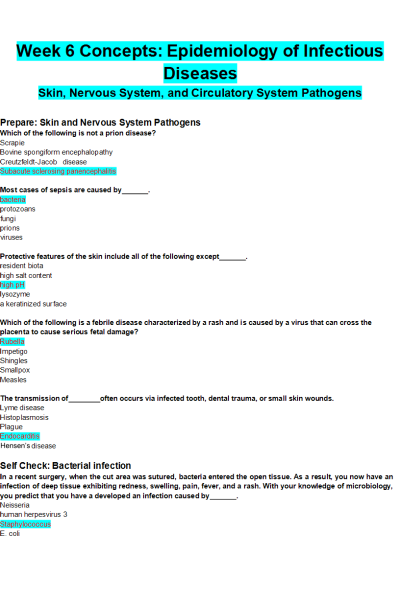BIOS 242 Week 6 Concepts; Epidemiology of Infectious Diseases
-
$25.00
| Institution | BIOS 242 Fundamentals of Microbiology with Lab - Chamberlain |
| Contributor | Anika Fultz |
Week 6 Concepts: Epidemiology of Infectious Diseases
Skin, Nervous System, and Circulatory System Pathogens
Prepare: Skin and Nervous System Pathogens
- Which of the following is not a prion disease?
- Most cases of sepsis are caused by .
- Protective features of the skin include all of the following except .
- Which of the following is a febrile disease characterized by a rash and is caused by a virus that can cross the placenta to cause serious fetal damage?
- The transmission of often occurs via infected tooth, dental trauma, or small skin wounds.
Self Check: Bacterial infection
- In a recent surgery, when the cut area was sutured, bacteria entered the open tissue. As a result, you now have an infection of deep tissue exhibiting redness, swelling, pain, fever, and a rash. With your knowledge of microbiology, you predict that you have a developed an infection caused by .
Self Check: Antimicrobial
- Many gyms are abundantly supplied with towels and antimicrobial sprays for wiping down equipment after each user. The reason for this is to cut down on the transmission of .
Self Check: Eye infection
- Your child has developed an eye infection with a yellowish discharge. You predict that this is a case of .
Self Check: Botulism
- True or False: In Botulism, the toxin binds to target sites on peripheral motor neurons on the spinal cord, brain, and sympathetic nervous system
Self Check: Prion transmission
- Prions can be transmitted by all of the following:
Self Check: Virulence factors
- A common virulence factor found in causative agents of meningitis (N. miningitides, S. pneumoniae, H. influenza, S. agalactiae, L. monocytogenes) is
Self Check: Subacute endocarditis
- Which of the following statements is incorrect regarding subacute endocarditis?
Self Check: Acute endocarditis
- Acute endocarditis is most commonly contracted through_____.
Self Check: Epstein-Barr virus
- Which of the following statements regarding the Epstein-Barr virus is incorrect?
Reflect: Skin and Nervous System Pathogens
- Staphylococcus can be differentiated from Streptococcus by the .
- The causative agent of trachoma is .
- Which of the following statements is incorrect regarding Listeria monocytogenes?
- The causative agent of Lyme disease is .
- Erythema migrans, a bull's-eye rash, at the site of a tick bite is associated with .
- Lyme disease is transmitted by .
- Symptoms of infectious mononucleosis include:
- When septicemia causes inflammation of the lymphatic vessels, it is called:
- Neonatal meningitis is most commonly transmitted by .
- Spongiform encephalopathies are:
| Instituition / Term | |
| Term | Uploaded 2023 |
| Institution | BIOS 242 Fundamentals of Microbiology with Lab - Chamberlain |
| Contributor | Anika Fultz |















































